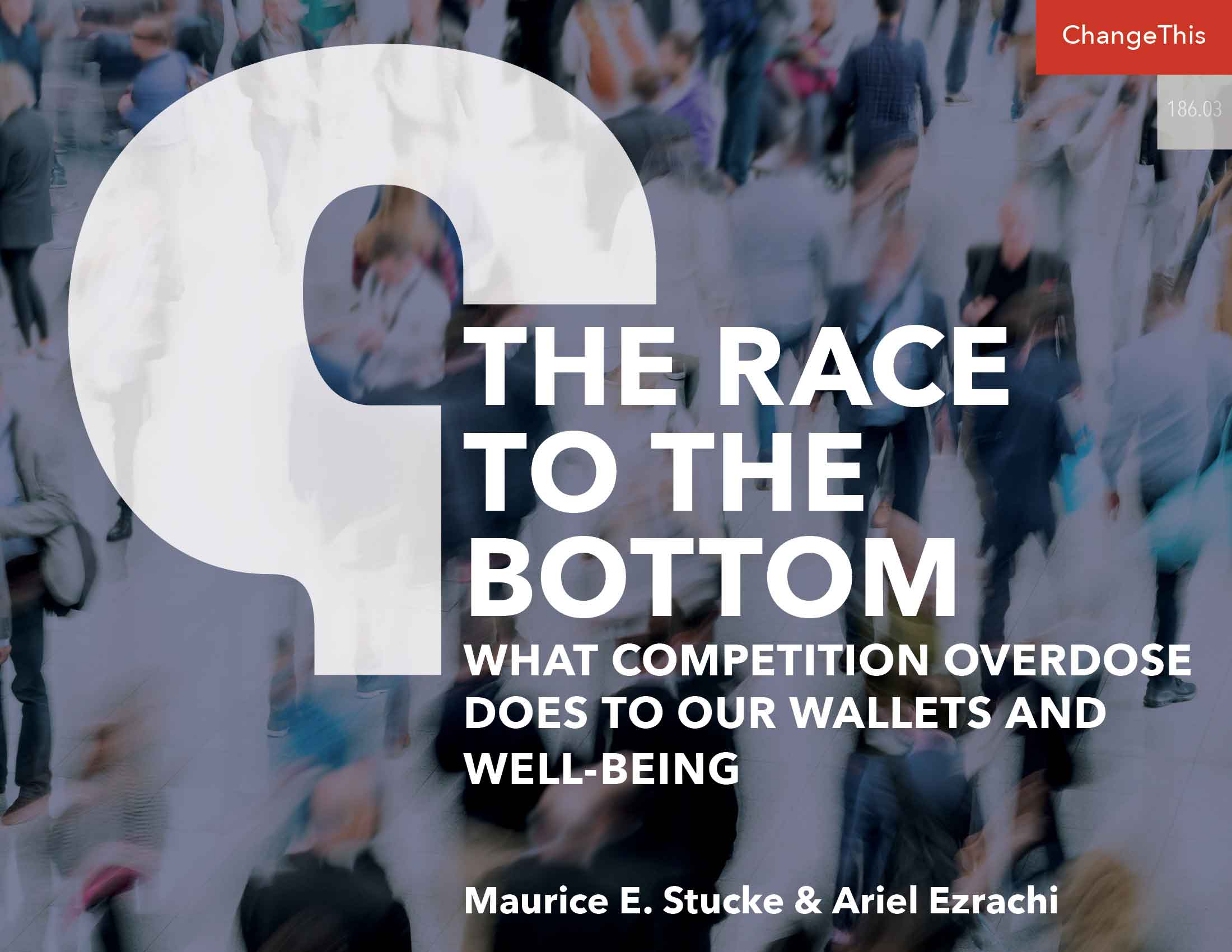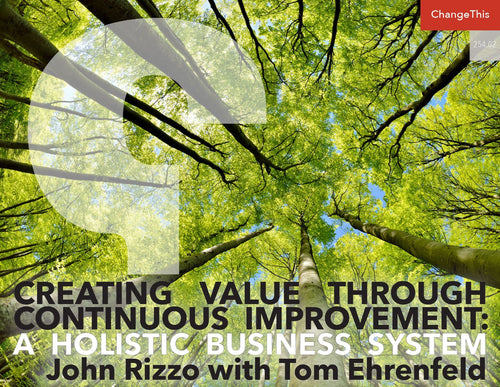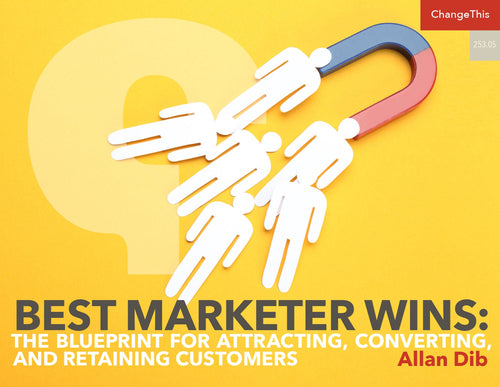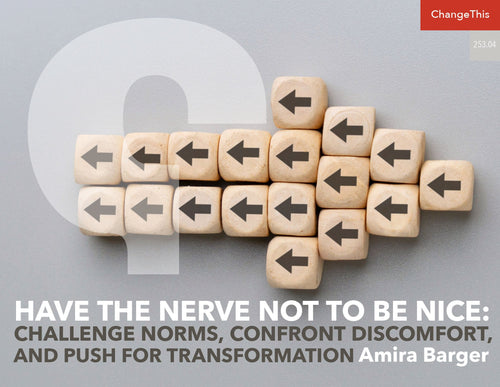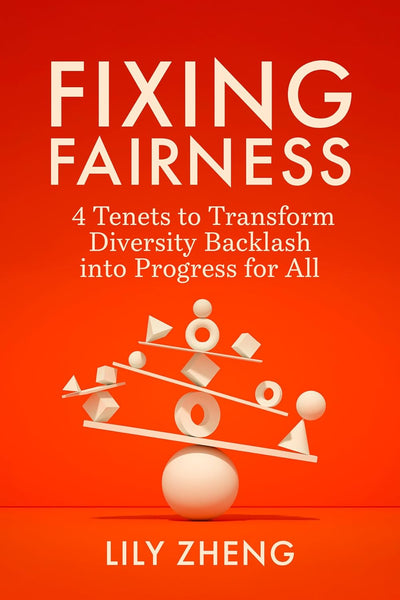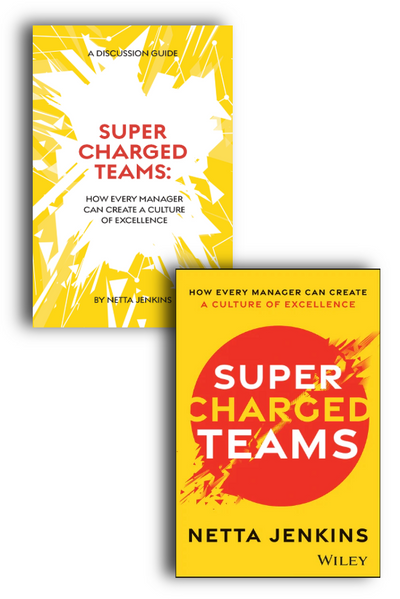The Race to the Bottom: What Competition Overdose Does to Our Wallets and Well-Being
Politics today is divisive. But there’s one subject on which just about everybody seems in agreement.
Have you ever heard any American politician question the benefits of competition? Or, to put it another way, have you ever heard any lawmaker or policy maker praise any policy for being anticompetitive?
Probably not.
The consensus is so absolute that it amounts to an almost religious belief in competition as the key to our prosperity: If a business behavior or law is pro-competitive, it’s inherently good; if anticompetitive, it’s presumptively bad.
As a result, whatever illness our society suffers, competition is often held up as the cure. Do we want better education for our children? Create competition among public schools. Better, more cost-effective, efficiently managed prisons? Same principle. Greater happiness? Same. Increase our range of choices—whether we’re talking about types of cheese, possible marriage partners, or job opportunities—through competition, and we’ll be happier and more prosperous. More competition promises to deliver what we want, often at a lower price.
Yet, many of us feel increasingly uneasy about the results of unbridled competition, even if we haven’t identified it as the cause of our problems. Despite the promise of prosperity, we may be working harder, longer hours at our jobs, but for less money, fewer or nonexistent benefits, and no security. And those low prices we pay may also mean lower quality. Often, we’re paying less, but getting much less. Our food has undeclared additives and dishonest labeling; our bargain airlines may be flying with dangerously low fuel loads. Or we indeed do pay less—for clothing, chocolate, and coffee, for example—but at the expense of the child slave laborers who produce these goods for us. Or we think we pay less—for our credit cards, for our hotels—but are actually being mercilessly exploited by companies that add hidden fees and may drive us into crippling debt. Or we pay little or nothing—in exchange for surrendering our privacy to the huge corporations that make billions off of us.
Often we are told that more competition is the cure for these ills, that the real problem is the bloated regulatory state. Should we continue down this path? Or is it time to wake up and notice that, beginning in the 1970s, competition has been overprescribed, the many regulations to protect us from overdosing have been stripped away, and the warning labels suggested by economists have been removed. As consumers and citizens, we have paid a hefty price. Rather than competition serving us, we now serve it, as our laws and economic policies turn us from citizen kings to market servants.
To be clear, we are not two crazy Bolsheviks, seeking to bring down the capitalist machine. Quite the opposite. We have spent the past two decades promoting competition in our writings, our speeches, and the work we have done for competition agencies around the world. Both of us, of decidedly middle-class backgrounds, were instilled from childhood with the virtues of competition—whether on the athletic field, in the classroom, or at work. From early in our professional lives, we have devoted ourselves to what we both believed to be the sacred cause of competition: for Maurice, it was prosecuting anticompetitive restraints and mergers at the US Department of Justice; for Ariel, it was establishing an institute at Oxford dedicated to promoting competition law and policy. Through our studies and our work, we learned that competition is indeed often the perfect cure—an engine for modern prosperity. And we continue every year to instill in our students the lessons about the benefits of competition.
However, while we still believe that competition is often good, we also now recognize that politicians and policy makers have been pushing competition as a magical elixir, even when it is ill-suited for the task at hand. We’ve also noticed that the competition ideal has been misused as a cover to promote policies that may actively harm citizens, while benefiting the companies that are exploiting them. Sometimes unwittingly, sometimes cynically, our lawmakers have sold us out, taking away our protections and removing our safety net, all in the name of encouraging ever more competition.
THE RACE TO THE BOTTOM
Two centuries after his death, the Scottish economist Adam Smith might still be the most powerful man in the world.
Although he only used the term a few times in his writing, Smith’s “invisible hand” became one of social science’s most well-known metaphors, and the foundational principle of a lot of complex economic systems. Everything from the price you pay for an apple at your local bodega to the machinations of multilateral international trade wars is influenced by a key assumption underlying Smith’s theory.
That assumption is that society is merely the sum of individuals—from which we can conclude that if each person acts to maximize his or her own well-being, this will inevitably maximize the overall well-being of society.
With that everyone wins. Abracadabra!
When the invisible hand casts its magic wand we end up with a competitive “race to the top,” a race that benefits each individual and the community as a whole. And, like any simple magic trick, it works quite well at a very basic level.
Competition can, in the right circumstances, deliver prosperity and economic growth. And since other strategies for achieving those same aims are far more complicated and far less predictable, competition has become the backbone of many countries’ economic policies.
Problem is, it sometimes fails to deliver. When it does, it often leaves individuals and society worse off. The invisible hand then becomes nothing more than a sleight of hand.
So when is competition a race to the bottom rather than to the top?
WHEN COMPETITION HARMS ITS INTENDED BENEFICIARY: PUBLIC SCHOOL EDUCATION
We often hear that greater competition among schools will benefit the students. The schools will just keep getting better and better and deliver their results at ever lower costs.
One economist voiced a common point of view: Greater competition can improve public school education in several ways. First, competition can improve schools’ efficiency (which means that you get “more achievement for the same dollar”); second, competition can increase innovation; and third, competition can ensure a better match between student and school so that students’ individual needs are met.
This seems great. Described this way, competition sounds like a race to the top, where the schools’ interests are aligned with the students’ individual and collective interests. The schools get better, the students get a better education.
And yet, seemingly beneficial unrestricted competition can backfire, spiraling into a race to the bottom that does the opposite of what we hope for—competition wastes resources, lessens innovation, harms students, and undermines the quality of their education.
How this happens has a lot to do with how we measure schools relative to each other—via metrics through which we create numbered rankings. The underlying assumption about such competitive rankings is simple: The higher-ranked schools do a better job educating their students. To attract prospective students, schools with lower rankings will have to improve, and everyone will end up benefiting.
Let us see how that works in the United Kingdom, where, as in the United States, rankings play a key role in spurring competition. What we (and many parents) have discovered is that in the schools’ quest to improve (or maintain) their rank, the ranking itself may become the main goal, while education can become ancillary. The children’s education is sacrificed to promote the school’s reputation.
One way this happens is when school administration officials pressure teachers to use grade inflation to improve their schools’ results and ranking. As one primary school teacher and blogger noted:
The reality is the stakes are so high for schools now, it’s just not reasonable to expect class teachers to make fair and reasonable judgments on things over which they could be hung out to dry.
The competitive pressure may lead schools and teachers to take even more extreme measures, to improve the perceived success. As chronicled in a 2017 UK documentary, this may involve orchestrated cheating. One former head teacher, for example, was caught and dismissed after altering his pupils’ Standard Assessment Tests. His explanation of his misdeeds is telling. Consistently bad test results may be detrimental to the school’s reputation, he observed:
Parents will then have a choice to keep their children at the School or move them… If a child leaves they’re taking money with them because you are funded based on the number of children you’ve got. Money is walking out of the School one by one…
A fellow Head Teacher rang me and his exact words were “the only thing you did wrong was you got caught.” I made a mistake and I paid the price.
Other teachers, with a similar motivation to cheat for the benefit of their schools’ ranking, were also altering exam answers and exam results and allowing students to copy work from course books. In another scandal that broke in 2017, teachers who were involved in setting the Cambridge International Pre-U exams revealed the questions to students in their respective schools. This cheating scandal implicated some of Britain’s most prestigious schools. Eton College’s deputy head, for example, was accused of sharing confidential information about a forthcoming economics exam. Winchester College’s head of art history was accused of tipping off students about two exams. Both resigned following the revelations.
Not surprisingly, we can see the same kind of toxic competition in other countries that seek to assess educational quality through competitive metrics and rankings. Investigators, for example, found at least forty-four schools in Atlanta, Georgia, engaged in cheating: Nearly “180 employees, including 38 principals, were accused of wrongdoing as part of an effort to inflate test scores and misrepresent the achievement of Atlanta’s students and schools.” That scandal, according to the FairTest organization, was just the tip of the test-cheating iceberg. FairTest identified widespread test-score corruption in thirty-nine states and in Washington, DC. According to FairTest’s public education director:
Across the country, strategies to boost scores without improving learning—including outright cheating, narrow teaching to the test and pushing out low-scoring students— have been widespread. These corrupt practices are one reason for the growing movement resisting politically mandated overuses and misuses of standardized exams.
Here again we see our first condition of toxic competition: If all the schools facilitate cheating, none of the schools, nor students, benefit. The schools’ individual interests and our collective interests diverge.
Rather than improving quality, competition instead leads to widespread grade inflation and cheating. And when teachers are pushed to satisfy the ranking gods, students graduate from primary schools with inflated marks that do not necessarily reflect their abilities. This puts greater pressure on the secondary schools, which have to deal with students who do not have the skills and knowledge needed to succeed at this next level. Those schools, too, will then be vulnerable to ranking pressure and the manipulations it leads to. As competition for relative position among the schools intensifies, the grading bubble expands. With increased competitive pressure and limited checks and balances, schools go from tolerating cheating to actually engaging in widespread fraud.
CHANGING BUSINESS AS USUAL
Companies can change the way they do business by changing the corporate culture in which their employees operate. As the Financial Crisis Inquiry Commission observed of the chief executives of companies whose failures drove us to the economic crisis: “These individuals sought and accepted positions of significant responsibility and obligation. Tone at the top does matter and, in this instance, we were let down. No one said ‘no.’” If the goal is to encourage competition that is ethical, fair, and ultimately designed for the benefit of not just shareholders, but of workers, customers, and society at large, that has to be made explicit, and the message has to go deeper than a company logo.
This process begins by asking: What is your company’s why? What is its social purpose? What values does your company promote? What values and traits of your company’s corporate culture will help it in achieving its social purpose? What values and traits will get in the way of its social purpose?
One common complaint is that companies have lost any sense of purpose beyond maximizing profits and, where applicable, shareholder value. Neither their executives nor their employees can identify any other kind of purpose—and many are not interested in doing so.
One extreme example is an investment bank that once took pride in its ethical organizational culture. Servicing its clients’ interests was paramount. But in one of the more famous resignation letters, Greg Smith, a Goldman Sachs executive director, described how toxic competition had eroded the financial institution’s once-prized culture:
How did we get here? The firm changed the way it thought about leadership. Leadership used to be about ideas, setting an example and doing the right thing. Today, if you make enough money for the firm (and are not currently an ax murderer) you will be promoted into a position of influence.
What are three quick ways to become a leader? a) Execute on the firm’s “axes,” which is Goldman-speak for persuading your clients to invest in the stocks or other products that we are trying to get rid of because they are not seen as having a lot of potential profit. b) “Hunt Elephants.” In English: get your clients—some of whom are sophisticated, and some of whom aren’t—to trade whatever will bring the biggest profit to Goldman. Call me old-fashioned, but I don’t like selling my clients a product that is wrong for them. c) Find yourself sitting in a seat were your job is to trade any illiquid, opaque product with a three-letter acronym.
Today, many of these leaders display a Goldman Sachs culture quotient of exactly zero percent. I attend derivatives sales meetings where not one single minute is spent asking questions about how we can help clients. It’s purely about how we can make the most possible money off of them. If you were an alien from Mars and sat in on one of these meetings, you would believe that a client’s success or progress was not part of the thought process at all.
It makes me ill how callously people talk about ripping their clients off. Over the last 12 months I have seen five different managing directors refer to their own clients as “muppets,” sometimes over internal e-mail. Even after the S.E.C., Fabulous Fab, Abacus, God’s work, Carl Levin, Vampire Squids? No humility? I mean, come on. Integrity? It is eroding. I don’t know of any illegal behavior, but will people push the envelope and pitch lucrative and complicated products to clients even if they are not the simplest investments or the ones most directly aligned with the client’s goals? Absolutely. Every day, in fact.
Of course, we see how unrestrained competition does not protect investors—whether the sophisticated client of Goldman Sachs or workers buying mutual funds, whose brokers recommended “high commission, low-yielding investments that resulted in Americans achieving returns that were about 1% lower than they should have been, costing investors about $17 billion annually.”
Regulation alone will not change corporate culture. We also need internal corporate guardrails, like management requiring brokers and other financial advisers to act as fiduciaries for their clients, acting in their clients’ best interests. Otherwise, as Smith noted, “You don’t have to be a rocket scientist to figure out that the junior analyst sitting quietly in the corner of the room hearing about ‘muppets,’ ‘ripping eyeballs out’ and ‘getting paid’ doesn’t exactly turn into a model citizen.” Ethical concerns have continued to overshadow Goldman Sachs and other financial institutions.
Such a corporate culture is toxic not only to the “muppets,” but ultimately to the company itself. Compare, for example, Goldman Sachs and Vanguard Group Inc., whose business culture the business professor Thomas Davenport found from his research represents the “anti-Goldman Sachs.” Whereas Goldman’s managing directors refer to their clients as “muppets,” Vanguard does the opposite: “People there are constantly reminding themselves that the idea is to help clients make better investment decisions at the lowest possible cost.” Whereas Goldman people “care only about making money,” Vanguard people “don’t seem hung up on the fact that people in other firms are more highly compensated on average; they seem to find it rewarding to know they’ve done the right thing for their customers. [P]eople there are constantly reminding themselves that the idea is to help clients make better investment decisions at the lowest possible cost.” Not surprisingly, in the decade after the financial crisis, a lot of the profits, assets, and influence have moved from Goldman Sachs and the other scandal-ridden investment banks to Vanguard and other money-management giants.
Let us move now beyond anecdotal examples and consider the numbers. Empirical observations suggest that having an ethical, social purpose that informs strategic decision-making helps companies unlock opportunities and increase profits.
In 2015, the Harvard Business Review surveyed 474 executives around the globe who were nearly unanimous in their assessment of the importance of a company’s having a purpose beyond profit—purpose being defined as “an aspirational reason for being which inspires and provides a call to action for an organization and its partners and stakeholders and provides benefit to local and global society.”
- 90 percent of the executives said their company understood the importance of a social purpose;
- 89 percent said a strong sense of collective purpose drives employee satisfaction;
- 84 percent said their business transformation efforts will have greater success if integrated with a purpose;
- 81 percent agreed that purpose-driven firms deliver higher-quality products/services; and
- 80 percent agreed that an organization with shared purpose will have greater customer loyalty.
Similarly, a 2014 Deloitte survey of 300 executives and 753 employees found that those who worked for an organization with a strong sense of purpose were more engaged and upbeat about the company’s future prospects. The top two reasons for their confidence were closely aligned with the ideals of noble competition: delivering top quality products/services and focusing on long-term sustainable growth.
Many employees care deeply about their firm’s moral, ethical, and social purpose. It can increase internal engagement and well-being, as well as external engagement. Having a strong purpose thus can benefit the firm. A 2019 study by Bates College and Gallup found that 80 percent of college graduates affirm the importance of finding purpose in their work, but less than half report having it. Consequently, Bates College, through its Center for Purposeful Work, is preparing its students “for lives of meaningful work [which] lies at the heart of the liberal arts mission.”
But don’t we want companies to maximize shareholder value, as opposed to prioritizing these other social purposes? It wasn’t on the top of either the Deloitte or Harvard surveys. Instead the top social purposes were having a meaningful impact on clients/ customers, and providing business services and/or products that benefit society.
The fact that generating financial returns is relatively low on the priority list doesn’t mean that purpose-driven companies aren’t successful. Quite the opposite. The Harvard Business Review survey showed that 58 percent of the companies with a clearly articulated purpose had experienced 10 percent or more growth in revenues over the past three years, with only 15 percent of them experiencing flat or declining revenues. By comparison, only 42 percent of the companies without a clear sense of purpose could claim 10 percent or more growth in revenues, and another 42 percent had flat or declining revenues.
As we saw with the behavioral experiments, greedy self-interested citizens do not make stronger economies. Likewise, companies bent solely on maximizing profits will not necessarily achieve their goal. But having a sense of purpose seems to unlock the kinds of energies that help them do so.
The Chicago School economist Milton Friedman famously argued that a company’s only social responsibility is to maximize profits “within the rules of the game.” However, the empirical evidence suggests that just as most of us hold ourselves to standards higher than “the rules of the game”—and we become collectively better off for behaving this way—the companies we work for should do likewise.
Of course, every company has a choice to make about its internal culture. But we see that employees want more from their employer than a paycheck; they want a social purpose. Noble competition unlocks that social purpose, directly benefiting society, while indirectly improving the company’s bottom line. Not a bad deal for the corporations, individuals, and society.

